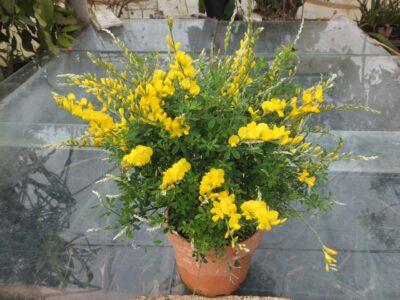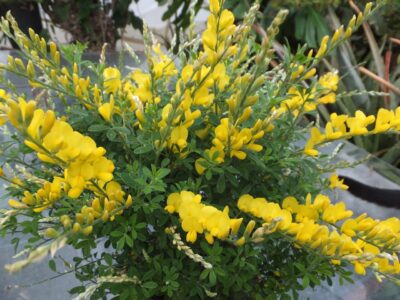
Genistas are excellent choices for hot dry greenhouses and conservatories especially those where you have little time to attend regularly. Although most Genistas are fairly hardy including some natives a majority of the near 70 species come from around the Mediterranean and so revel in hot dry positions under a fierce sun. Most are deciduous, some evergreen, some thorny, many would make large shrubs, others such as G. falcata are dwarf, a few have perfume. But all bear trouble free healthy foliage and a profusion of the most glorious yellow flowers. And most perform really well in containers, need little attention, withstand the accidental forgotten watering and altogether are very obliging, pest and disease resistant.
Their beautifully golden flowers are obviously from the pea family so are leguminous making their own fertility and suited to poor heaths and thin soils. Indeed these much resemble and are closely related to the Laburnums, the Cytisus Brooms and Ulex Gorses. Perhaps the species most often seen is G. hispanica which is known as Spanish Gorse and has a pleasing scent of ripe apples with a hint of pineapple. Naturally many of their names show similar conflation with their other close relations so our native G. anglica is Needle Furze or Petty Whin both of which are yet more names for Gorse. The vanilla scented G. aetnensis is Mount Etna Broom, G. januensis Genoa Broom and G. sylvestris Dalmatian Broom. A thoroughly Classical ancestry.

In practice these all grow well in sandy acid or neutral free draining composts though are not actually lime intolerant like most heathers (which they might be under-planted with to extend their season of interest). Genistas are tough survivors however they will resent over-watering, may even die if waterlogged and will not benefit from heavy feeding- so as noted above almost the perfectly designed plants for occasional neglect.
Although most species can be started from seed as with so many plants the finest varieties need to be propagated by cuttings or grafts. Young shoots take easily. Even so these are inexpensive and can be purchased currently in two dozen different species and varieties, a goodly number for a collection -particularly if you want naught but yellow flowerers.


